- 1. Integration of Garden and Home: Garden Design and Interior Complement Each Other
- 2. Responsible design: eco-friendly materials, support of local flora and fauna
- 3. Natural Landscape: Free Forms, Wild Plants, and Natural Texture
- 4. Serene Color Palette
- 5. Seasonal Aesthetics: Selecting Plants for Year-Round Decorative Appeal
- 6. Smart technologies: gadgets that simplify garden maintenance
- 7. Expansion of functional zones: spaces for meditation, creativity, and remote work
- 8. Loose materials: active use of gravel, crushed stone, and pebbles
- 9. Sensory garden: plants and decor that stimulate the senses
- 10. Decorative grasses: herbaceous borders, hedges, and accent compositions
- 11. Complex landscape: garden design with altered terrain, elevations, and slopes
- 12. Vertical gardening: green walls and hedges
- 13. Fire pit area: stylish terrace with an open fireplace
The periods of pandemic and lockdowns have taken the garden to a new level. It has turned into a multi-functional space that performs several tasks at once, without losing aesthetics and comfort. We talk about garden design solutions that are relevant in 2022.
Integration of Garden and Home: Garden Design and Interior Complement Each Other
The boundaries between the spaces of the home and garden continue to blur. There are more plants and natural elements inside the house, while outside, open spaces with comfortable furniture, appliances, lighting, and decor are becoming more common.
By connecting the interior and exterior spaces, one can increase the living space, invite more nature into the home, and make the garden experience even more comfortable and enjoyable. To achieve this, designers suggest:
- Adding more windows or replacing solid walls and doors with glass to maximize natural light and views.
- Using the same flooring in both the home and garden structures.
- Extending covered areas (e.g. from the entrance of the house to the gate or gazebo).
- Creating an open terrace as a smooth transition from the house to the garden.
- Using natural materials for garden architecture.
- Enhancing garden lighting (e.g. with garlands, functional fixtures, hidden lighting).
- Planting hanging plants near the entrance.
- Choosing comfortable garden furniture with cozy textiles.
It is important to have a cohesive concept between the countryside home and garden.

Responsible design: eco-friendly materials, support of local flora and fauna
Eco-style and conscious consumption remain the main priorities in modern design. This year, in the arrangement of gardens, great attention is paid to natural, recycled, and environmentally friendly materials (wood, wicker, ceramics, brick, concrete, glass). Among the plants, local species and varieties that attract pollinating insects are in favor.
Interesting fact! One of the popular trends in eco-gardening is growing forest mushrooms in the yard. For this, water left over from mushroom processing is poured under garden trees or mushroom spawn is scattered throughout the garden.

To support local wildlife in the garden, bird feeders and water stations are created, as well as shelters for hedgehogs, frogs, and bees. Organic fertilizers are preferred. Landscape designers urge to conserve water consumption and maintain healthy soil through proper drainage systems and mulching.
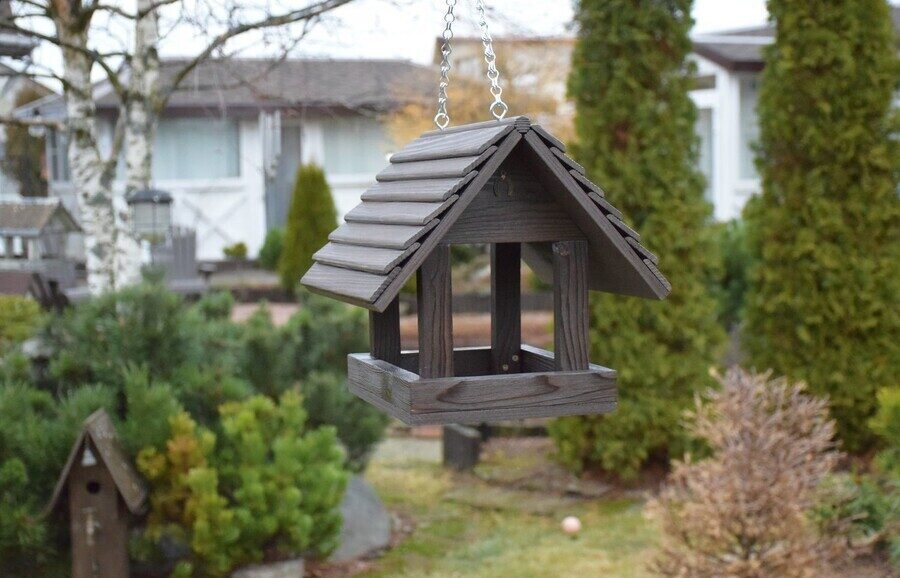
Natural Landscape: Free Forms, Wild Plants, and Natural Texture
Wild gardens or the natural garden style will be in high demand this year. The less human intervention in the garden design, the better. Smooth transitions, curved lines, blurred boundaries, a combination of garden crops with wild ones – everything in the landscape should resemble a natural landscape.
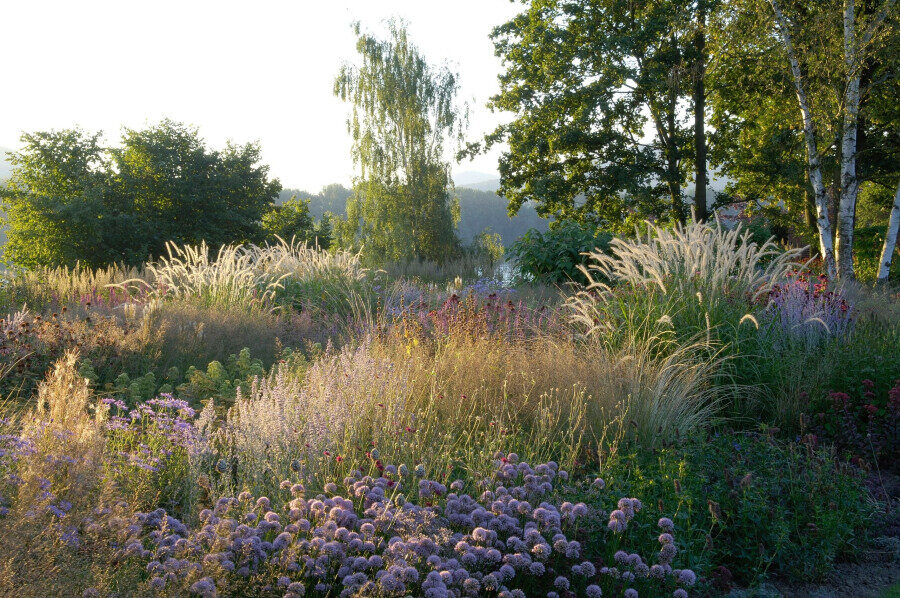
Wild gardens or the naturgarden style will be in high demand this year. The less human intervention in the garden design, the better. Smooth transitions, curved lines, blurred boundaries, the combination of garden cultures with wild ones – everything in the landscape should resemble a natural landscape.
Natural objects (stumps, gnarls, boulders) and untreated materials (wooden planks, pebbles, wicker) rich in texture and neutral in color deserve a lot of attention. Their highlight is their imperfection, their ability to change over time, to be covered with moss or overgrown with grass, similar to the metamorphoses in the wild.
Among the popular plants for the garden in 2022 are chrysanthemums, dahlias, zinnias, asters, forget-me-nots, arborvitae, barberry, decorative grasses and cereals.
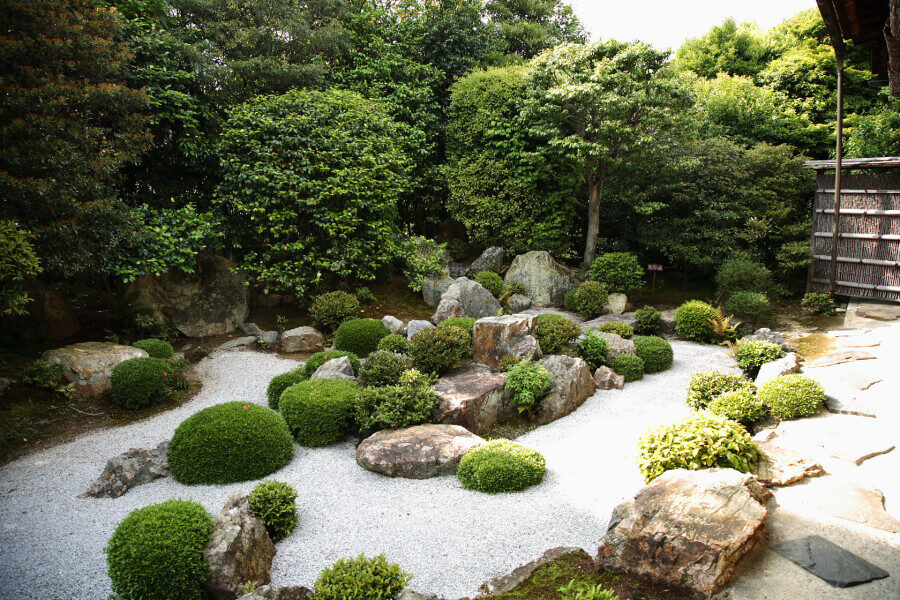
Serene Color Palette
In most modern gardens, no more than three colors prevail. Colorful Moorish lawns give way to monochrome calming flowerbeds. Among the favorites are shades of white and blue. Yellow and soft pink complement them perfectly.

Bright plants with unusual coloring will help to set accents, emphasize different zones of the garden, and transitions. Dark burgundy and chocolate-colored varieties are in fashion, but a natural color palette is still highly valued in garden design.
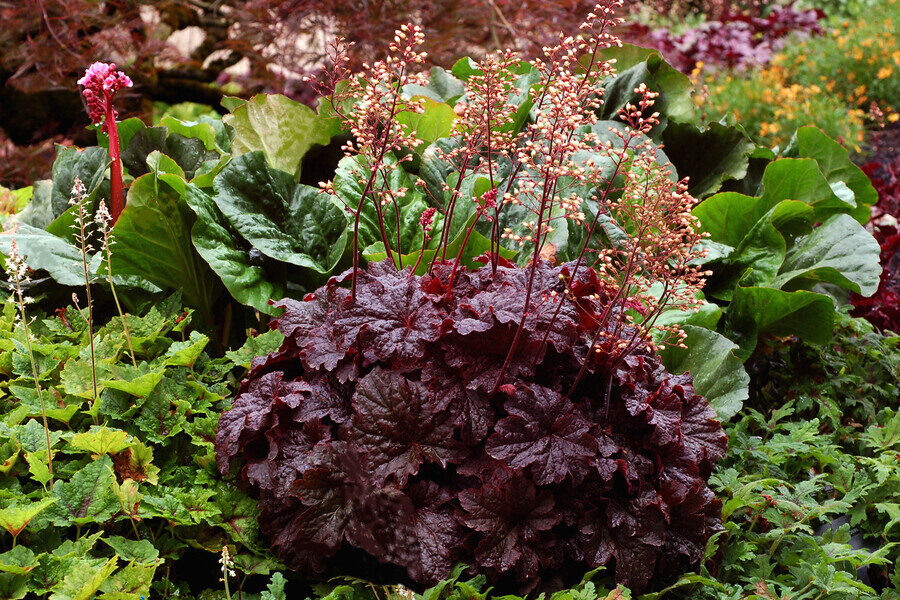
Seasonal Aesthetics: Selecting Plants for Year-Round Decorative Appeal
When planning landscape design, designers recommend considering the decorative appeal of plants throughout different seasons, so that as one type of plant fades, others gradually bloom in its place. Even in early spring and winter, a garden can look aesthetically pleasing thanks to certain types of grasses, trees, or shrubs.
Some beautiful and popular plants for the autumn garden include Virginia creeper, beautyberry, red oak, chrysanthemums, miscanthus, winterberry, and maple.
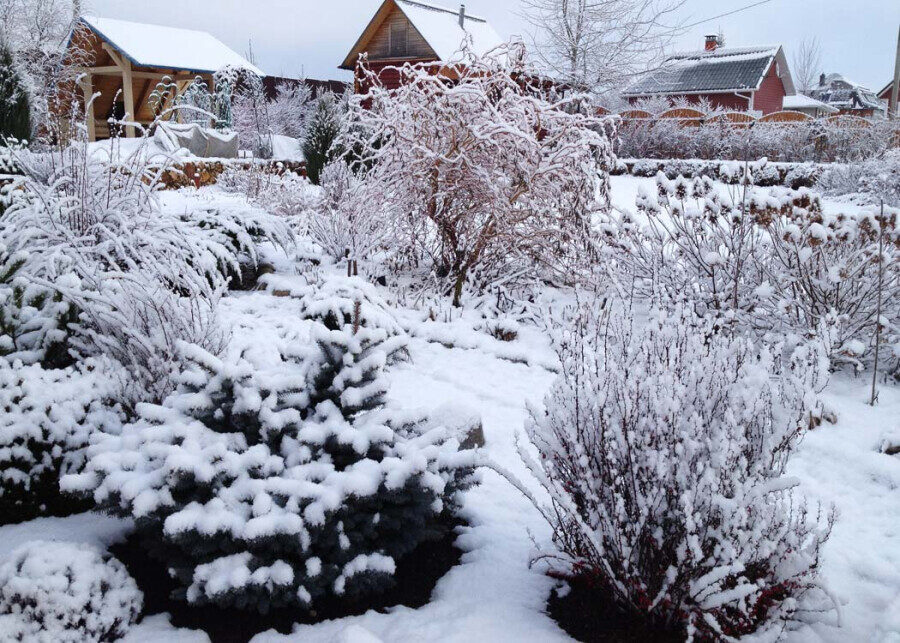
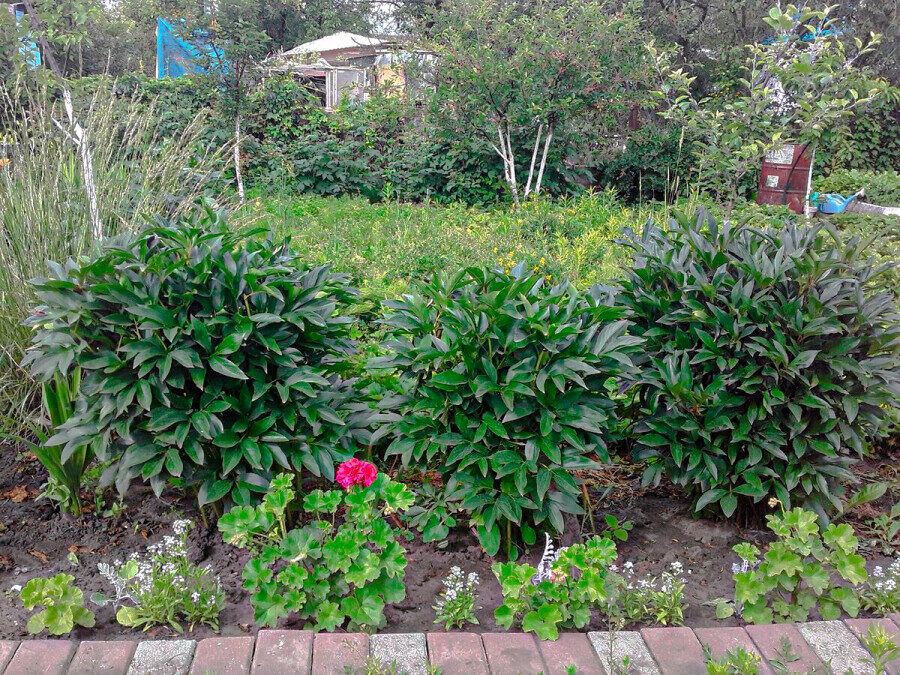
Smart technologies: gadgets that simplify garden maintenance
Gardening that doesn’t take up too much time and effort is now possible. Labor-saving technologies, events, and equipment come to the rescue: from sets for growing and seed dispensers to smart automatic watering systems and mobile gardening applications. They save time and energy, and provide more opportunities to enjoy leisure time in the garden.
Tip! Raised beds allow for creating beautiful landscape designs and simplifying plant care.
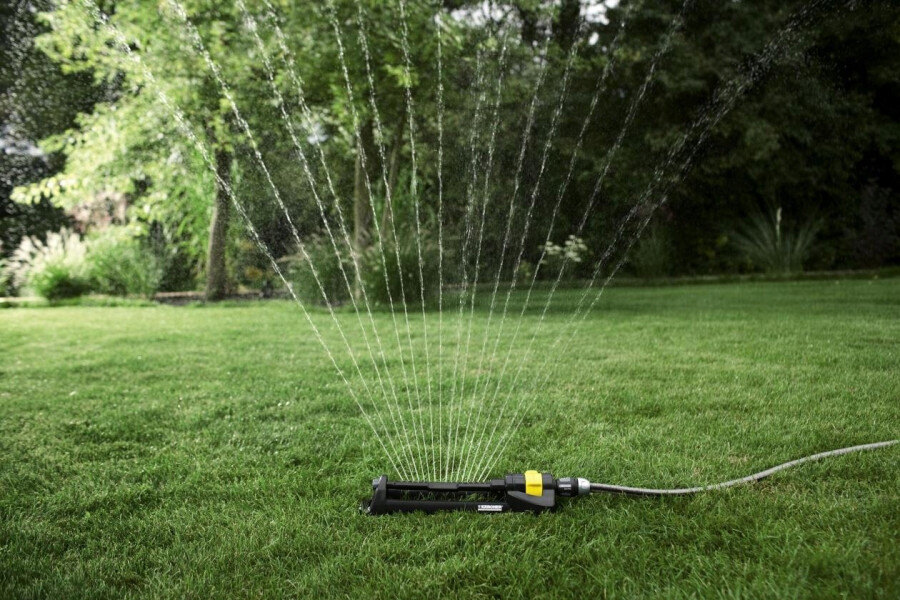
The concept of a “fast garden” gains momentum every year, which is easy to maintain and can be created in just a few days thanks to ready-made plants, smart tools, and materials. Container gardening is convenient for small backyard spaces, allowing plants to be moved around and grown indoors during the offseason.
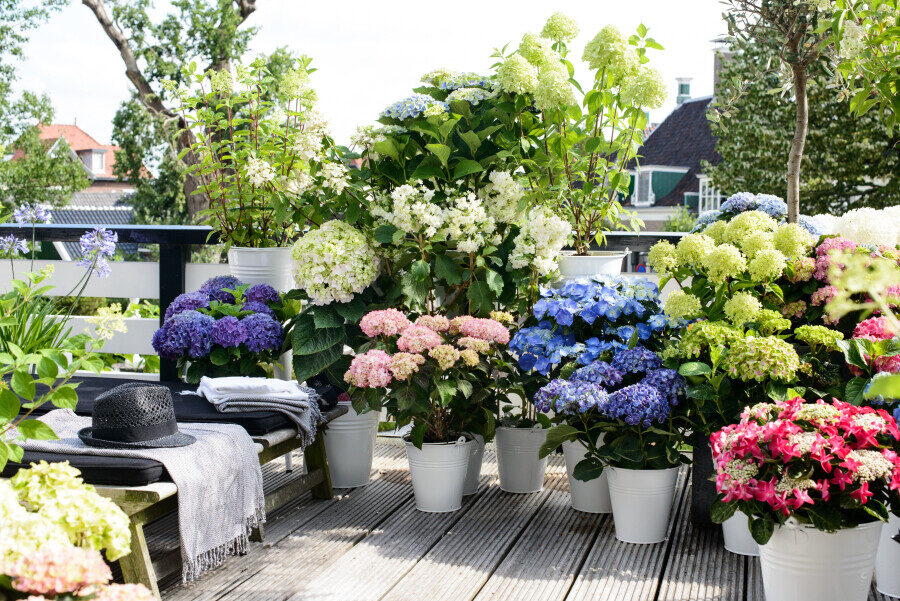
Expansion of functional zones: spaces for meditation, creativity, and remote work
The number of these spaces is increasing: in addition to the fruit garden and patio, areas for sports, meditation, sunbathing, sitting around a fire pit, creativity, and work are appearing. Instead of borders, there are living borders, walls made of trailing plants and trees. The lawn gradually ceases to be the decorative focus in garden design.
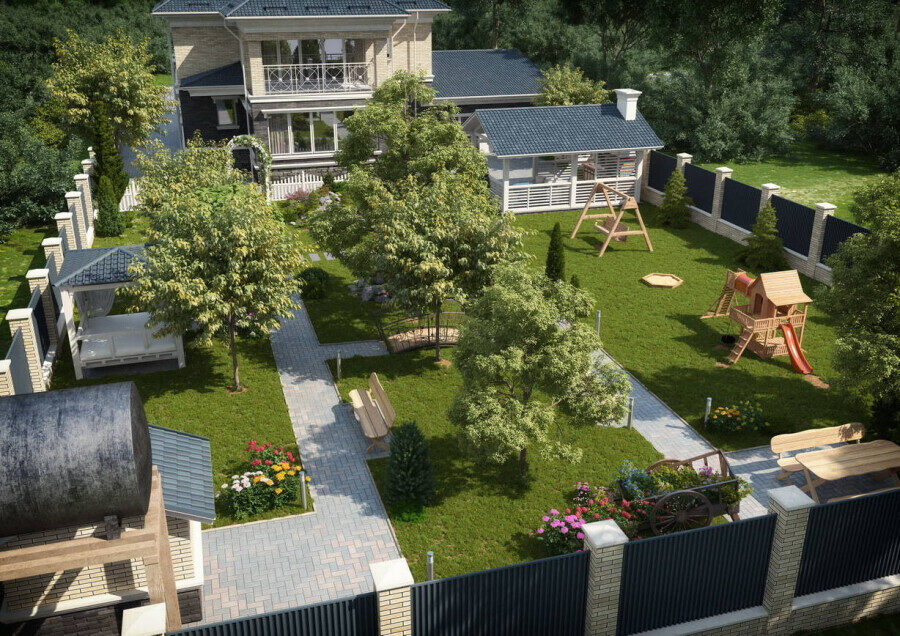
During the pandemic, a new type of garden structure gained popularity – the office gazebo or workspace equipped with a desk and computer. These structures are located in secluded corners of the garden surrounded by plants without strong aromas or bright colors, so as not to distract from the work process.

Loose materials: active use of gravel, crushed stone, and pebbles
The time of concrete paving stones and bulky stones is passing. Pathways that look natural and emphasize the natural landscape are in demand. They are sprinkled with gravel, crushed stone, pebbles, natural mulch, or laid with living grass. Using loose materials for paths, you can arrange recreation areas or parking lots.
Tip! Against the background of stony coverings, many plants look more spectacular, especially various heathers.
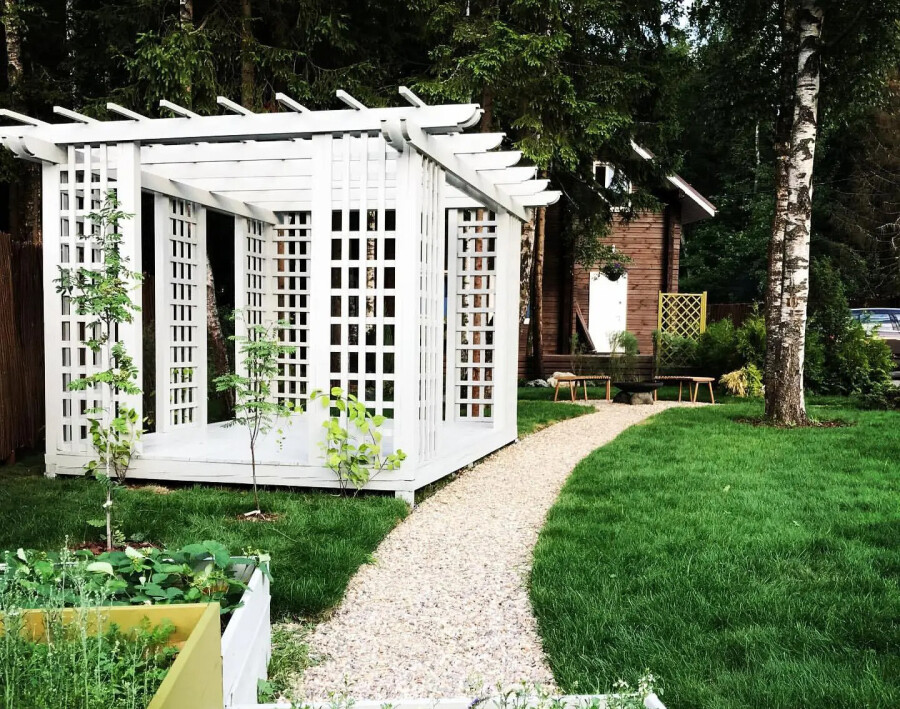
Another option for using gravel, pebbles, and stones is to create dry streams. They can easily decorate front yard flower beds, zone the space, hide unattractive areas of the garden and utilities. Instead of stone borders along the paths, perennials are sown.

Sensory garden: plants and decor that stimulate the senses
In recent years, the healing role of a garden and its benefits in combating anxiety and stress have become particularly relevant. Rest areas are increasing and being improved, and a soothing color palette and plants with pleasant aromas are in demand. Landscape designers suggest intensifying sentimentality by stimulating all the senses.
To achieve this, you can:
- Plant flowers that evoke pleasant memories of a loved one
- Create a feast for the eyes by designing a flower bed with flowers of different shades, heights, shapes, and textures
- Attract more birds to the garden by installing birdhouses and feeders
- Enjoy the sound of flowing water by adding fountains and streams
- Plant fragrant plants near the house or patio
- Leave space for plants with soft leaves and stems that are pleasant to touch along the pathways
- Create a bed for decorative grasses that rustle mysteriously in the wind.
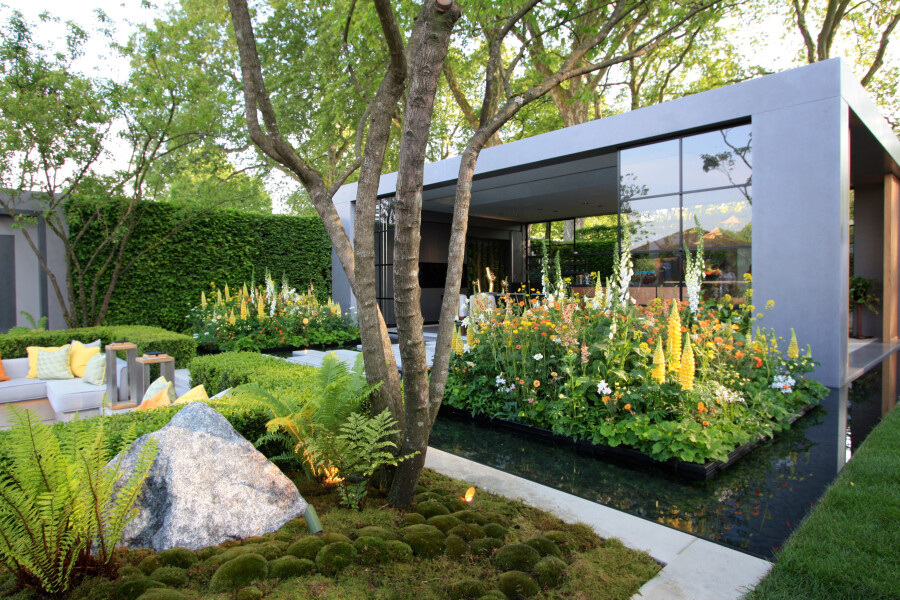
Decorative grasses: herbaceous borders, hedges, and accent compositions
The trend for grasses came along with the natural garden style. They are undemanding and aesthetic, easy to grow and combine with other plants in the garden. Grasses create an impressive texture, a background for flower beds, living borders, and hedges.
Important! Grasses have self-seeding tendencies, so in the spring they should be inspected and rid of excess shoots to prevent aggressive spread throughout the garden.
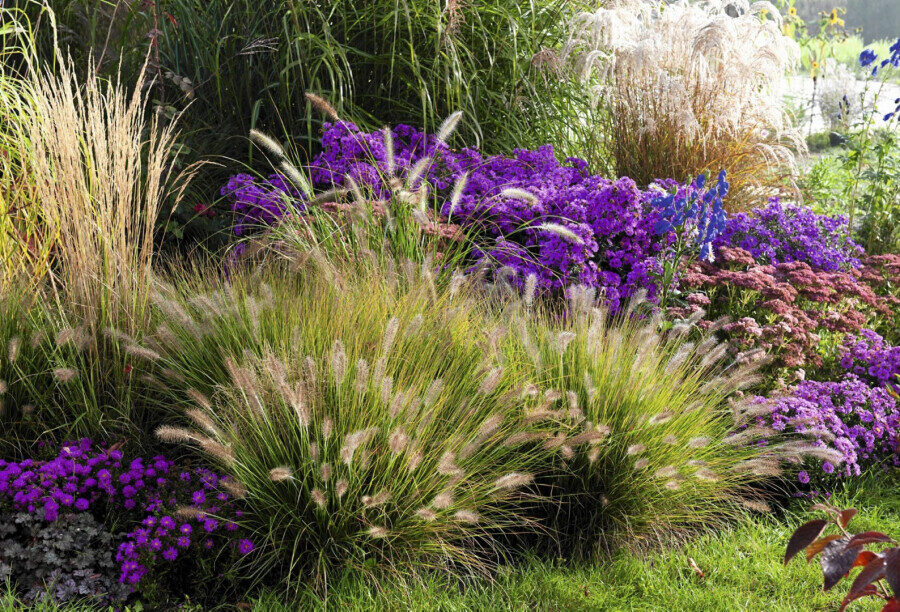
Many types of grasses look great throughout the year, including winter. Their only enemies are aphids and ticks, which can be eliminated with a powerful stream of water or soapy water solution. Grasses and grains are not very demanding of soil composition and fertilizers, making them a good option for owners of plots with poor soil. Herbaceous plantings go well with trailing plants, conifers, roses, and lilies.
Tip! The best decoration for a grassy bed is a few picturesque boulders and small gravel.
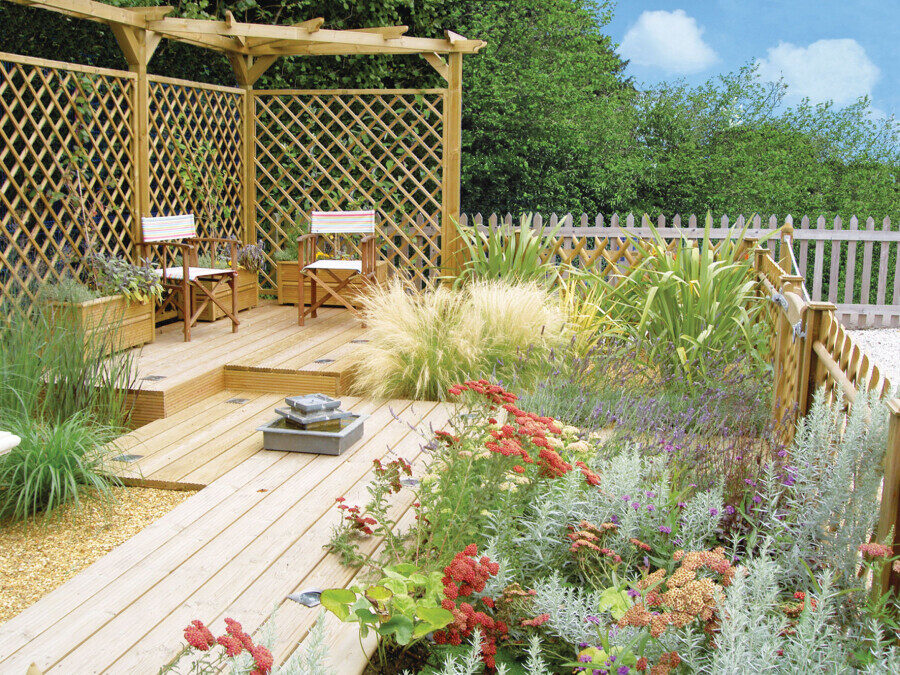
Complex landscape: garden design with altered terrain, elevations, and slopes
A garden with a complex multi-level landscape looks much more spectacular than plantings on a single flat plane. This year, geoplastics are in trend: embankments, hills, steps, dams, recesses, water features, and mounds. Different levels help to zone the garden and provide an opportunity to experiment with materials.
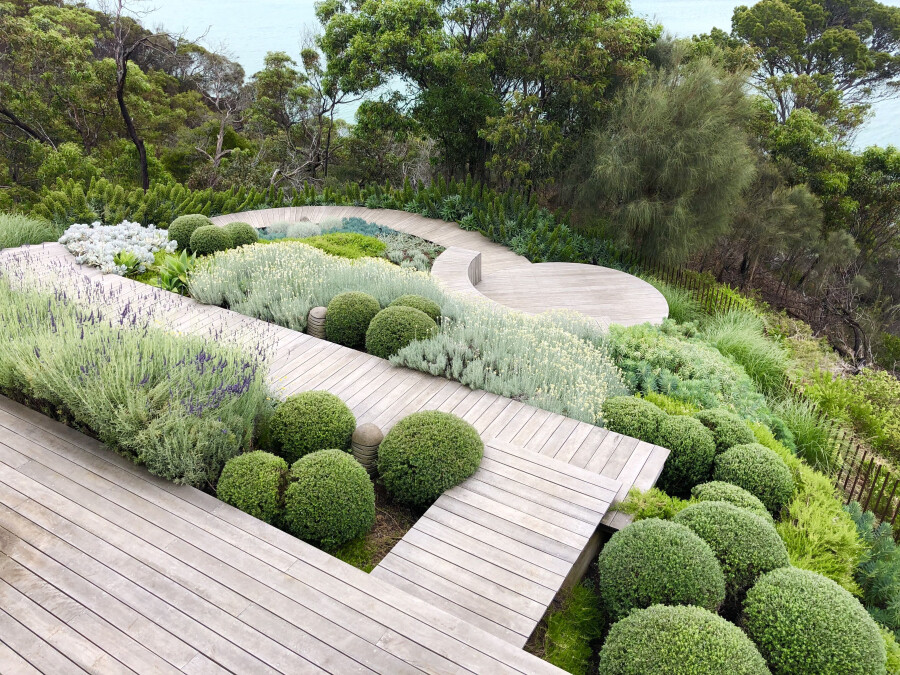
Stairs leading to terraces create a focal point in the design and a sense of journey, gradually revealing new areas of the garden. Built-in raised beds at different heights can fill different sightlines. It is important for the geoplastics to be harmonious and maintain a natural balance of the landscape.
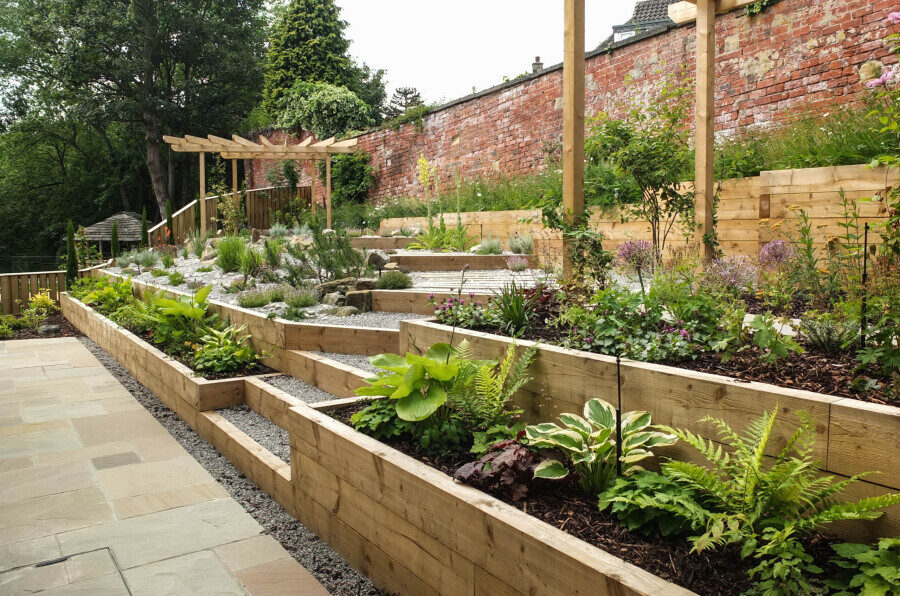
Vertical gardening: green walls and hedges
Garden owners are increasingly interested in privacy and seclusion. To achieve this, high solid walls are erected, supplemented with rows of dense shrubs or trees, instead of fences.
Important! Climbing plants for a live hedge must be hardy, unpretentious, and suitable for the local climate zone.
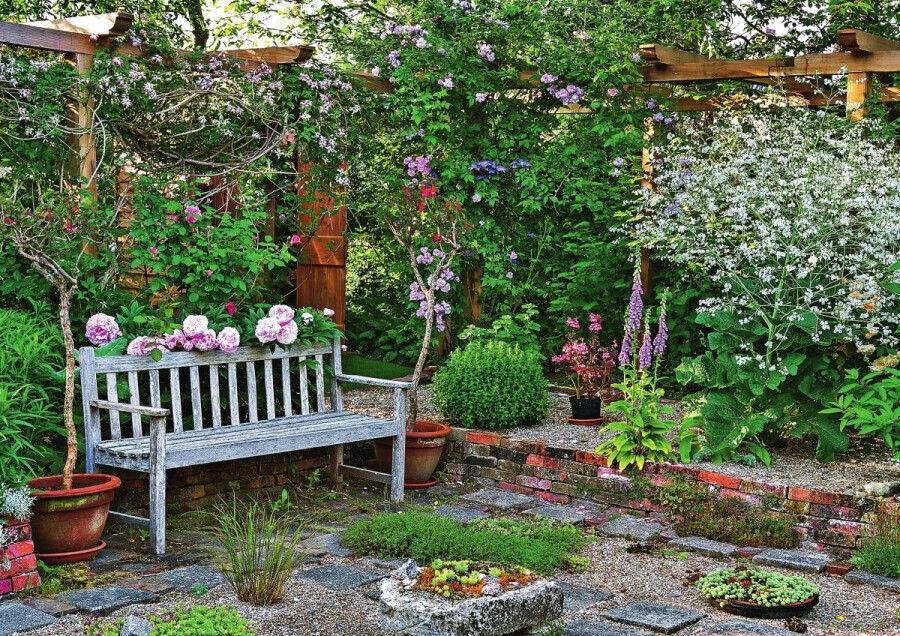
Secluded spots in the depth of the garden are surrounded by pergolas and high espaliers densely covered with trailing plants or various types of green walls. Two or three-level plantings protect from wind and drafts: at the top level are trees or large shrubs, slightly lower are low-growing shrubs and grasses, and at the very bottom are perennials.
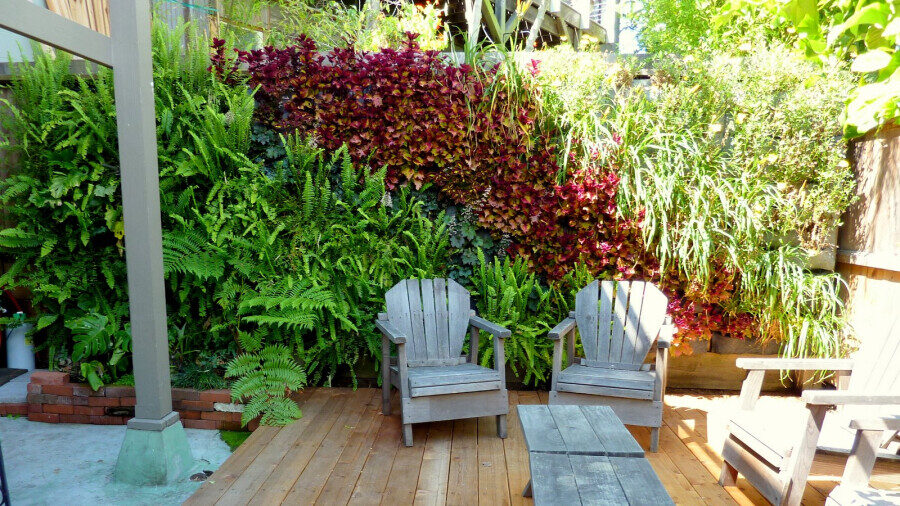
Fire pit area: stylish terrace with an open fireplace
Contemplating the fire in the fireplace mesmerizes and soothes. It’s even more enjoyable to do this outdoors in your own garden. This is how the idea of an open fire pit area was born, which became super popular in landscape design in 2022. This is not about grills and barbecues, but about an aesthetic terrace with a modern designer fire pit made of metal or concrete, surrounded by comfortable seating.
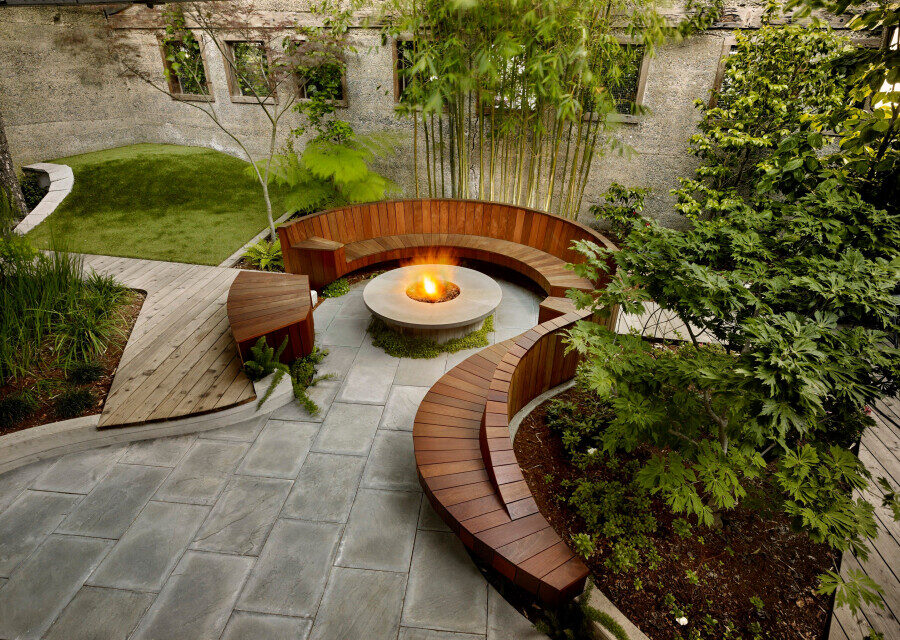
This is a place for contemplation, meditation, romantic evenings, and heart-to-heart conversations with loved ones and friends. But if desired, the fire pit can be used for cooking as well. Additionally, pergolas with garlands or vines, garden furniture with cozy textiles, and plants in vases are placed around it.
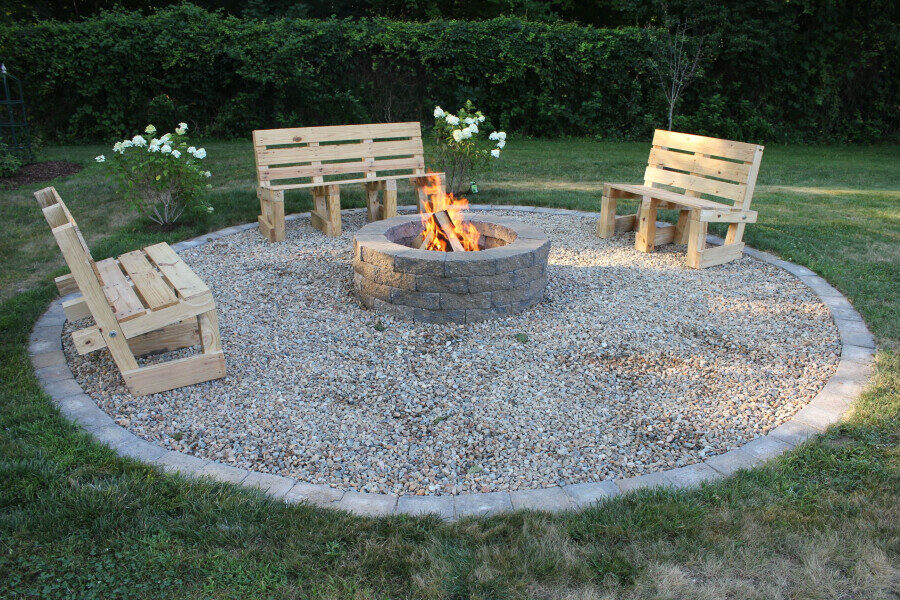
The modern garden is a multifunctional space where the focus is on plantings and structures that provide year-round aesthetics.


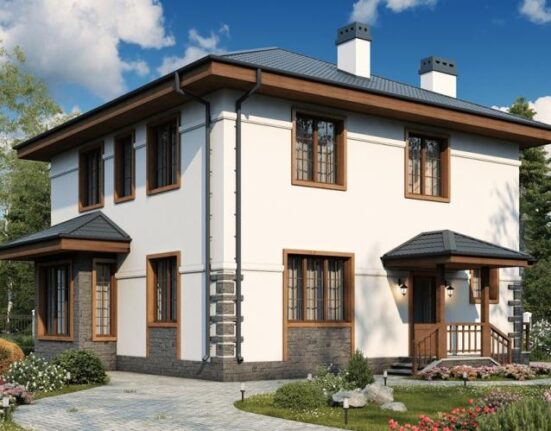

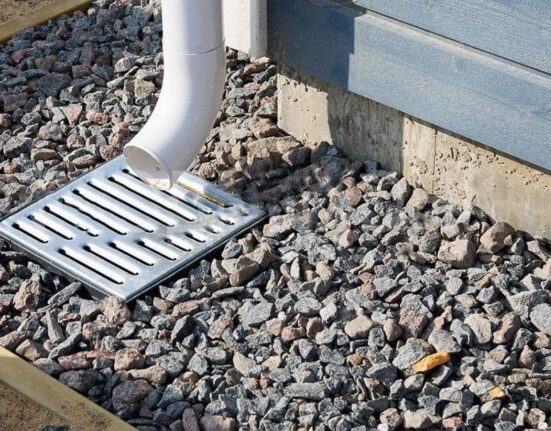
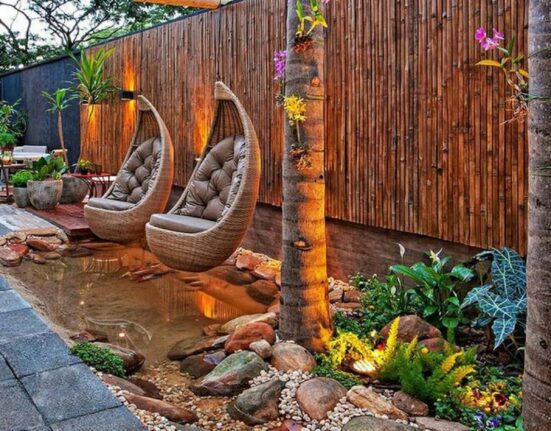
Leave feedback about this